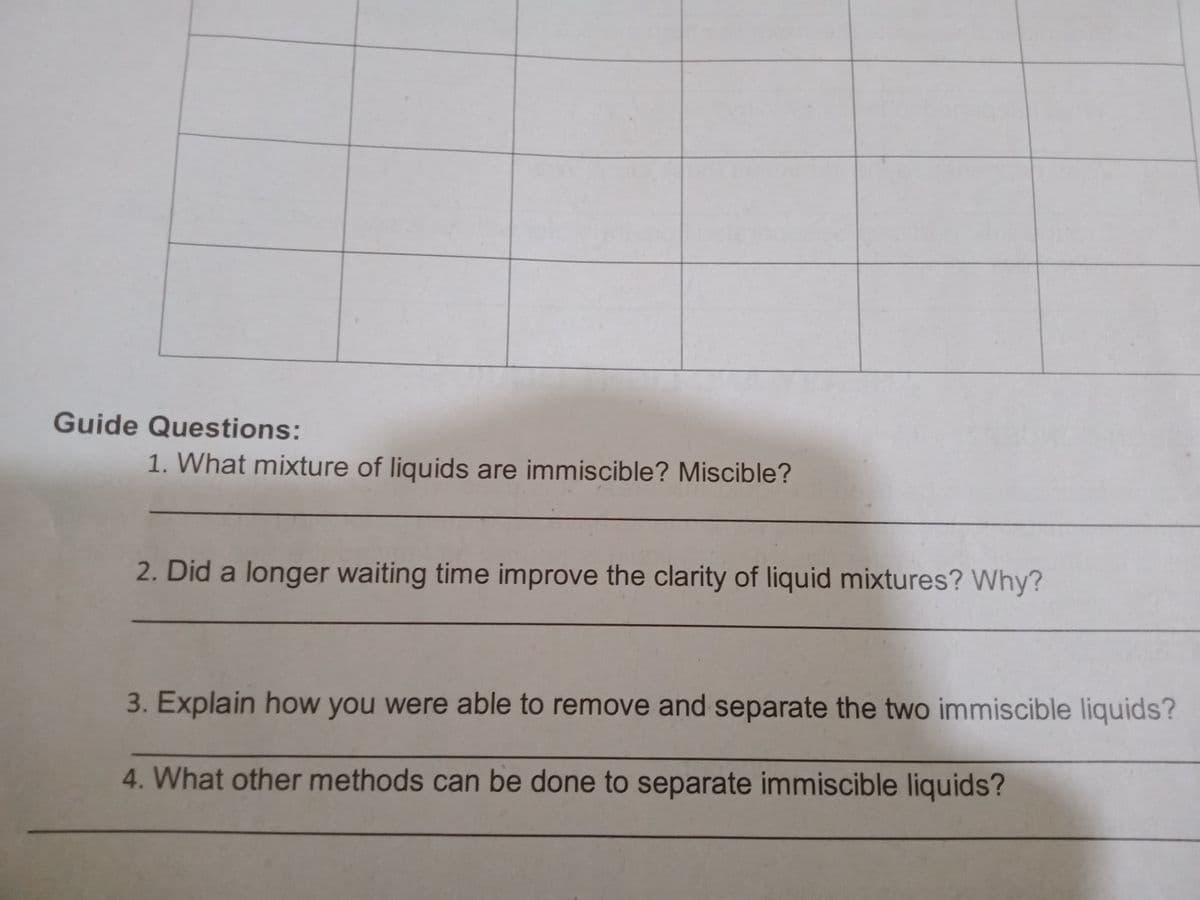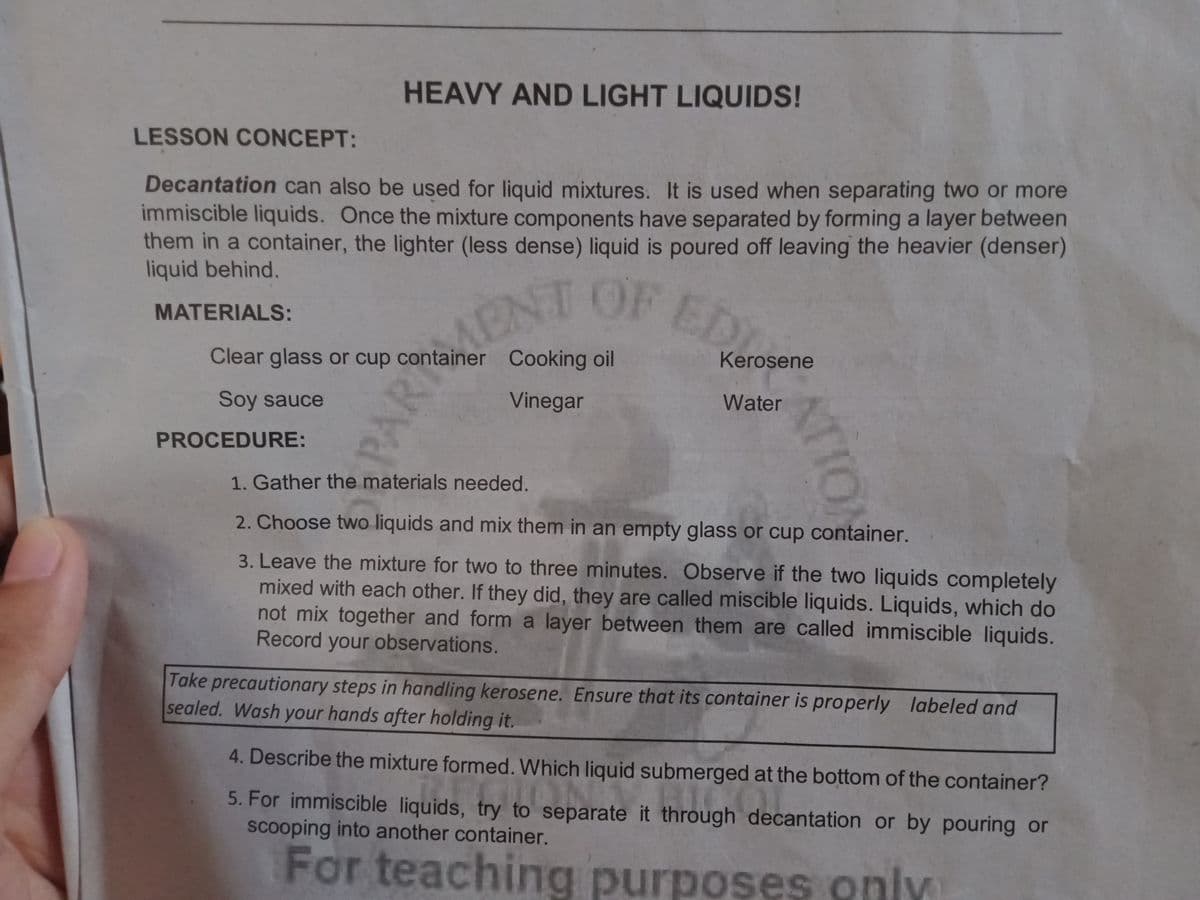1. What mixture of liquids are immiscible? Miscible? 2. Did a longer waiting time improve the clarity of liquid mixtures? Why? 3. Explain how you were able to remove and separate the two immiscible liquids? 4. What other methods can be done to separate immiscible liquids?
1. What mixture of liquids are immiscible? Miscible? 2. Did a longer waiting time improve the clarity of liquid mixtures? Why? 3. Explain how you were able to remove and separate the two immiscible liquids? 4. What other methods can be done to separate immiscible liquids?
Chemistry: Principles and Reactions
8th Edition
ISBN:9781305079373
Author:William L. Masterton, Cecile N. Hurley
Publisher:William L. Masterton, Cecile N. Hurley
Chapter1: Matter And Measurements
Section: Chapter Questions
Problem 56QAP: Magnesium chloride is an important coagulant used in the preparation of tofu from soy milk. Its...
Related questions
Question
Pls help me I'm just grade 6 please answer the questions shortly and concise thank u experts love ❤️

Transcribed Image Text:Guide Questions:
1. What mixture of liquids are immiscible? Miscible?
2. Did a longer waiting time improve the clarity of liquid mixtures? Why?
3. Explain how you were able to remove and separate the two immiscible liquids?
4. What other methods can be done to separate immiscible liquids?

Transcribed Image Text:HEAVY AND LIGHT LIQUIDS!
LESSON CONCEPT:
Decantation can also be used for liquid mixtures. It is used when separating two or more
immiscible liquids. Once the mixture components have separated by forming a layer between
them in a container, the lighter (less dense) liquid is poured off leaving the heavier (denser)
liquid behind.
T OF
MATERIALS:
Clear glass or cup container Cooking oil
Kerosene
Soy sauce
Vinegar
Water
PROCEDURE:
1. Gather the materials needed.
2. Choose two liquids and mix them in an empty glass or cup container.
3. Leave the mixture for two to three minutes. Observe if the two liquids completely
mixed with each other. If they did, they are called miscible liquids. Liquids, which do
not mix together and form a layer between them are called immiscible liquids.
Record your observations.
Take precautionary steps in handling kerosene. Ensure that its container is properly labeled and
sealed. Wash your hands after holding it.
4. Describe the mixture formed. Which liquid submerged at the bottom of the container?
5. For immiscible liquids, try to separate it through decantation or by pouring or
scooping into another container.
For teaching purposes only
Expert Solution
This question has been solved!
Explore an expertly crafted, step-by-step solution for a thorough understanding of key concepts.
This is a popular solution!
Trending now
This is a popular solution!
Step by step
Solved in 3 steps

Knowledge Booster
Learn more about
Need a deep-dive on the concept behind this application? Look no further. Learn more about this topic, chemistry and related others by exploring similar questions and additional content below.Recommended textbooks for you

Chemistry: Principles and Reactions
Chemistry
ISBN:
9781305079373
Author:
William L. Masterton, Cecile N. Hurley
Publisher:
Cengage Learning

General Chemistry - Standalone book (MindTap Cour…
Chemistry
ISBN:
9781305580343
Author:
Steven D. Gammon, Ebbing, Darrell Ebbing, Steven D., Darrell; Gammon, Darrell Ebbing; Steven D. Gammon, Darrell D.; Gammon, Ebbing; Steven D. Gammon; Darrell
Publisher:
Cengage Learning

Chemistry: Matter and Change
Chemistry
ISBN:
9780078746376
Author:
Dinah Zike, Laurel Dingrando, Nicholas Hainen, Cheryl Wistrom
Publisher:
Glencoe/McGraw-Hill School Pub Co

Chemistry: Principles and Reactions
Chemistry
ISBN:
9781305079373
Author:
William L. Masterton, Cecile N. Hurley
Publisher:
Cengage Learning

General Chemistry - Standalone book (MindTap Cour…
Chemistry
ISBN:
9781305580343
Author:
Steven D. Gammon, Ebbing, Darrell Ebbing, Steven D., Darrell; Gammon, Darrell Ebbing; Steven D. Gammon, Darrell D.; Gammon, Ebbing; Steven D. Gammon; Darrell
Publisher:
Cengage Learning

Chemistry: Matter and Change
Chemistry
ISBN:
9780078746376
Author:
Dinah Zike, Laurel Dingrando, Nicholas Hainen, Cheryl Wistrom
Publisher:
Glencoe/McGraw-Hill School Pub Co

Chemistry for Engineering Students
Chemistry
ISBN:
9781285199023
Author:
Lawrence S. Brown, Tom Holme
Publisher:
Cengage Learning

Chemistry for Engineering Students
Chemistry
ISBN:
9781337398909
Author:
Lawrence S. Brown, Tom Holme
Publisher:
Cengage Learning

World of Chemistry, 3rd edition
Chemistry
ISBN:
9781133109655
Author:
Steven S. Zumdahl, Susan L. Zumdahl, Donald J. DeCoste
Publisher:
Brooks / Cole / Cengage Learning